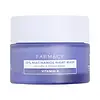What's inside
What's inside
 Key Ingredients
Key Ingredients

 Benefits
Benefits

 Concerns
Concerns

 Ingredients Side-by-side
Ingredients Side-by-side

Water
Skin ConditioningPropanediol
SolventNiacinamide
SmoothingC15-19 Alkane
SolventCaprylic/Capric Triglyceride
MaskingGlycerin
HumectantPanthenol
Skin Conditioning1,2-Hexanediol
Skin ConditioningCetearyl Olivate
Cetearyl Alcohol
EmollientSorbitan Olivate
EmulsifyingButyrospermum Parkii Butter
Skin ConditioningBetaine
HumectantVaccinium Corymbosum Seed Oil
AntioxidantTocopheryl Acetate
AntioxidantBeta-Glucan
Skin ConditioningBisabolol
MaskingAllantoin
Skin ConditioningMelia Azadirachta Flower Extract
Skin ConditioningGlycogen
HumectantCoccinia Indica Fruit Extract
Skin ConditioningLactobacillus Ferment
Skin ConditioningCorallina Officinalis Extract
Skin ConditioningSolanum Melongena Fruit Extract
Skin ConditioningAloe Barbadensis Flower Extract
EmollientSimmondsia Chinensis Seed Oil
EmollientZingiber Officinale Root Extract
MaskingCurcuma Longa Root Extract
MaskingOcimum Basilicum Flower/Leaf Extract
TonicOcimum Sanctum Leaf Extract
Skin ConditioningMaltodextrin
AbsorbentArginine
MaskingCarbomer
Emulsion StabilisingPentylene Glycol
Skin ConditioningSodium Phytate
Melia Azadirachta Leaf Extract
Skin ConditioningCaprylyl Glycol
EmollientWater, Propanediol, Niacinamide, C15-19 Alkane, Caprylic/Capric Triglyceride, Glycerin, Panthenol, 1,2-Hexanediol, Cetearyl Olivate, Cetearyl Alcohol, Sorbitan Olivate, Butyrospermum Parkii Butter, Betaine, Vaccinium Corymbosum Seed Oil, Tocopheryl Acetate, Beta-Glucan, Bisabolol, Allantoin, Melia Azadirachta Flower Extract, Glycogen, Coccinia Indica Fruit Extract, Lactobacillus Ferment, Corallina Officinalis Extract, Solanum Melongena Fruit Extract, Aloe Barbadensis Flower Extract, Simmondsia Chinensis Seed Oil, Zingiber Officinale Root Extract, Curcuma Longa Root Extract, Ocimum Basilicum Flower/Leaf Extract, Ocimum Sanctum Leaf Extract, Maltodextrin, Arginine, Carbomer, Pentylene Glycol, Sodium Phytate, Melia Azadirachta Leaf Extract, Caprylyl Glycol
 Reviews
Reviews

Ingredients Explained
These ingredients are found in both products.
Ingredients higher up in an ingredient list are typically present in a larger amount.
Niacinamide is a multitasking form of vitamin B3 that strengthens the skin barrier, reduces pores and dark spots, regulates oil, and improves signs of aging.
And the best part? It's gentle and well-tolerated by most skin types, including sensitive and reactive skin.
You might have heard of "niacin flush", or the reddening of skin that causes itchiness. Niacinamide has not been found to cause this.
In very rare cases, some individuals may not be able to tolerate niacinamide at all or experience an allergic reaction to it.
If you are experiencing flaking, irritation, and dryness with this ingredient, be sure to double check all your products as this ingredient can be found in all categories of skincare.
When incorporating niacinamide into your routine, look out for concentration amounts. Typically, 5% niacinamide provides benefits such as fading dark spots. However, if you have sensitive skin, it is better to begin with a smaller concentration.
When you apply niacinamide to your skin, your body converts it into nicotinamide adenine dinucleotide (NAD). NAD is an essential coenzyme that is already found in your cells as "fuel" and powers countless biological processes.
In your skin, NAD helps repair cell damage, produce new healthy cells, support collagen production, strengthen the skin barrier, and fight environmental stressors (like UV and pollution).
Our natural NAD levels start to decline with age, leading to slower skin repair, visible aging, and a weaker skin barrier. By providing your skin niacinamide, you're recharging your skin's NAD levels. This leads to stronger, healthier, and younger looking skin.
Another name for vitamin B3 is nicotinamide. This vitamin is water-soluble and our bodies don't store it. We obtain Vitamin B3 from either food or skincare. Meat, fish, wheat, yeast, and leafy greens contain vitamin B3.
The type of niacinamide used in skincare is synthetically created.
Learn more about NiacinamidePentylene glycol is typically used within a product to thicken it. It also adds a smooth, soft, and moisturizing feel to the product. It is naturally found in plants such as sugar beets.
The hydrophilic trait of Pentylene Glycol makes it a humectant. As a humectant, Pentylene Glycol helps draw moisture from the air to your skin. This can help keep your skin hydrated.
This property also makes Pentylene Glycol a great texture enhancer. It can also help thicken or stabilize a product.
Pentylene Glycol also acts as a mild preservative and helps to keep a product microbe-free.
Some people may experience mild eye and skin irritation from Pentylene Glycol. We always recommend speaking with a professional about using this ingredient in your routine.
Pentylene Glycol has a low molecular weight and is part of the 1,2-glycol family.
Learn more about Pentylene GlycolWater. It's the most common cosmetic ingredient of all. You'll usually see it at the top of ingredient lists, meaning that it makes up the largest part of the product.
So why is it so popular? Water most often acts as a solvent - this means that it helps dissolve other ingredients into the formulation.
You'll also recognize water as that liquid we all need to stay alive. If you see this, drink a glass of water. Stay hydrated!
Learn more about Water